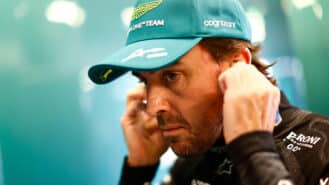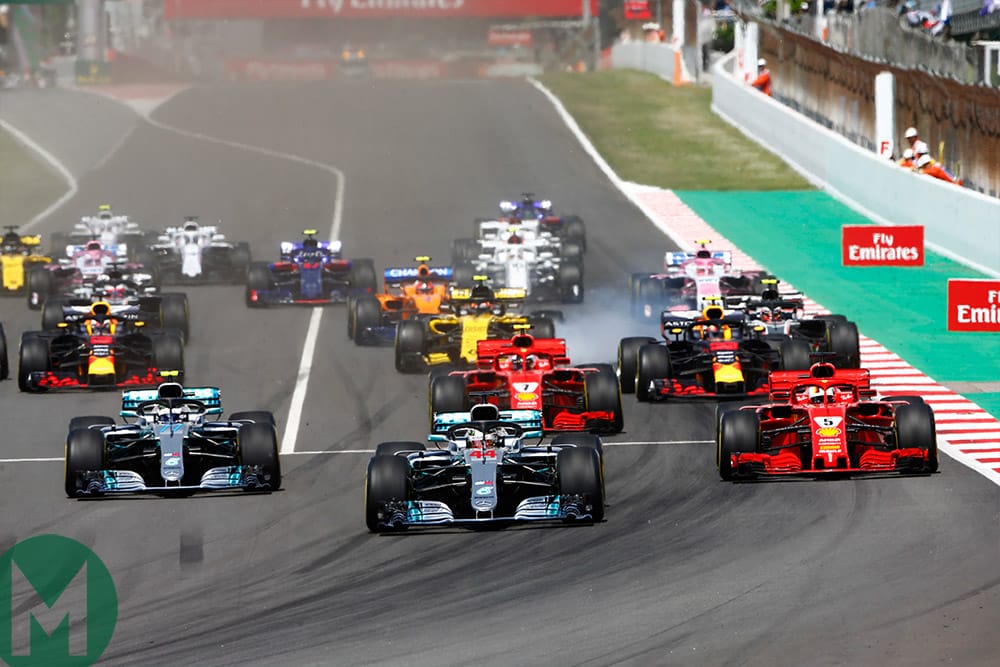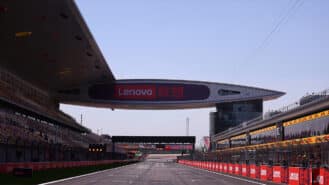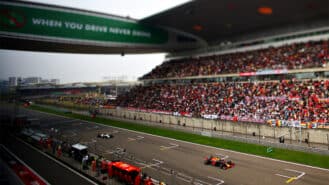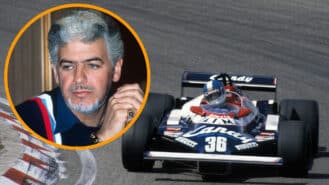All it takes is a tricky combination of temperature, track surface and thinner-gauge rubber, and the competitive picture changes completely. We saw it from Melbourne to the contrasting Bahrain/China/Baku run of races and we saw the symmetrical return to the Melbourne picture here with a dominant Mercedes. Except, this time, Lewis Hamilton was able to convert that dominance into victory.
Valtteri Bottas made it a clean sweep for the team, with Red Bull’s Max Verstappen taking advantage of Ferrari’s appetite for rubber to nip ahead for the final podium place as Sebastian Vettel made a second stop.
But Formula 1 being what it is, the conspiracy theories ran rife. Paranoia is only ever a glance away in the paddock and although the competitive pattern made perfect sense to the engineers, many others were looking for wilder explanations.
Qualifying
A track resurfaced last winter, new thinner-gauge tyres, and a circuit layout that punishes and rewards different aspects of tyre behaviour so that there’s far less difference in lap time between compounds than usual. The ingredients had been shuffled a little for this one – with the result that there was no clear fastest tyre. The supersoft should have been that tyre, and in the cool conditions of qualifying it probably could have been a couple of tenths faster than the soft. But it took a lot to find those extra tenths: to not have the fronts too cold at the start of the lap and the rears too hot at the end. The soft was much easier to prepare, nowhere near as sensitive and, in the tricky gusty conditions, might actually have been the better bet.
This unusual offset between the compounds was almost certainly created in part by the introduction of the new thin-gauge tyre. At the behest of the teams, Pirelli has invented it this year to limit blistering around the long-duration fast corner circuits of Barcelona, Paul Ricard, Silverstone, Spa and Suzuka. But the reduction in the gauge obviously changes the thermal properties of the tyre and around a hot Barcelona on Friday the supersoft was wildly overheating by the end of the lap. On a much cooler Saturday, that problem was less severe, but it was still a tricky tyre – and even if you fully exploited it, it was at best two-tenths faster than the soft. Many teams reckoned there was literally no difference in lap time potential.
Consequently, apart from Fernando Alonso’s McLaren, every car that made it through Q2 did so on the soft tyre. This included the Ferrari, Mercedes, Red Bull and Haas teams plus Carlos Sainz’s Renault. They could all, therefore, potentially benefit from a longer opening race stint than would be possible on the supersoft.
Into Q3, when it was only about one-lap pace, the choice was less clear-cut. For the first runs everyone went out on supersofts and Lewis Hamilton’s Merc went fastest by 0.3sec from Verstappen’s Red Bull – and both Ferraris locked up and ran wide at Turn 1, their fronts not up to temperature. So for the second runs, Ferrari switched wholesale to the softs, but Mercedes stayed with supersofts. At Red Bull, Verstappen stayed with supersofts while Ricciardo switched to softs.
Hamilton’s final attempt shaved 0.3sec off his first; Bottas put a proper lap together, having suffered a moment at Turn 1 on his first, and was within half-a-tenth of Hamilton. Vettel did likewise but the soft just didn’t have quite the ultimate grip of the super and he was consigned to third fastest, a tenth and a half adrift of pole. It suggested that had Ferrari been able to get the super working, pole was well within its grasp.
“I just didn’t like the feel of that tyre,” said Vettel afterwards. “With the thinner tread the tyre is harder, basically. I asked to go back to the [soft]; it was my choice and I think for us it was the right call because I just didn’t get a great feeling with the other tyre.”
Kimi Räikkönen lined up fourth, 0.3sec off Vettel. He’d lost an engine on Friday, losing him a bit of set up time and he concurred with Vettel about the feel of the car on the supers. Although slightly grippier, the rear super had more movement than the more stable soft. Both Ferraris ran with their controversial new halo-mounted mirrors incorporating winglets some way above, with a thin connecting rod to classify the mirror/winglet as one component. The FIA promptly banned it, effective from the next race.
Red Bull filled the third row, the super-shod Verstappen two-thousandths quicker than Ricciardo who was on softs. Verstappen suffered a moment on his final attempt and abandoned it.
“Obviously, it’s difficult for us when the others turn up their engines,” said Verstappen. “So we just have to try and keep as close as we can. You have to consider that from Turn 1 to Turn 4 is flat out now, also Turn 7 to Turn 10. It is like having two more straights out there, so relies even more on the engine power.”
Ricciardo did near enough identical times on both compounds of tyre: “With the laps we put in I thought we would be more like a couple of tenths from pole,” he said, “not six or seven [tenths], as our car didn’t feel too bad, which is a little frustrating.” The RB14 featured a very extensive update with re-positioned radiators to allow a significant re-profiling of the sidepods. There were appropriate accompanying changes to the bargeboards.
There was a 0.8sec gap to the best of the rest – in this case Kevin Magnussen’s Haas, who was a couple of tenths and three places ahead of team mate Romain Grosjean. In between the Haas pair were Alonso’s updated McLaren with its new nose and accompanying changes, and Sainz’s also-upgraded Renault, the latter keeping intact his 100 per cent record of out-qualifying his team-mates around this track. It wasn’t exactly a fair comparison on this occasion as Nico Hülkenberg’s car had suffered a lack of fuel pressure in Q1 and failed to graduate from there, back in 16th.
Stoffel Vandoorne was a couple of tenths off team-mate Alonso in Q2, which wasn’t quite enough to get him into Q3, and he lined up 11th feeling the changes to the car were a very positive development. Pierre Gasly was wringing everything from the Toro Rosso all weekend and his time on used softs (he had no more new ones left) put him 12th. With a different tyre allocation, Q3 definitely looked feasible. His speed seemed to step up the pressure on team-mate Brendon Hartley who, on Saturday morning, lost his car in a big way after putting a wheel on the grass going into Turn 9 and suffering a big impact with the tyre barriers that destroyed the STR13. He took no part in qualifying.
The Force Indias were nowhere near the competitive entities they’d been in Baku, without the specific Mercedes advantage that track’s layout had given them, and Esteban Ocon and Sergio Perez struggled to 13th and 15th, sandwiching the again-impressive Charles Leclerc, who out-paced his 17th fastest Sauber team-mate by 0.8sec. Slowest cars – around 1sec slower than Force India – were the Williams FW41s, with Sergey Sirotkin out-pacing Lance Stroll. Every attempt to turn this car into a corner looked like a risky undertaking and it is now clear that its aerodynamics simply do not work when the car is in any state of yaw. Stroll was off the track at various points in the weekend, including his final Q1 effort. Robert Kubica had driven the car in first practice (where he was 1.2sec faster than Stroll) and reported that just keeping the car on the track was a monumental feat. Again, the comparative performance to Baku (where it had been knocking on the door of Q3) illustrated the particular Mercedes advantage at that track that doesn’t apply elsewhere.
Race
The sun was out by the 3pm start, though there were dark clouds threatening off to the south-east. The wind had died down but the rumours had not. The thin-gauge tyres had clearly been made specifically for the benefit of Mercedes, said some. Merc had struggled with tyres in the previous three races, went the theory, and had applied political pressure – and lo and behold the Mercedes had recaptured its status as the fastest car. Except it was nonsense.
Conspiracy debunking
1) The request for thinner-gauge tyres on fast corner tracks had come from a number of teams – but led by Mercedes, McLaren and Ferrari – after winter testing here on the new surface had revealed worrying degrees of blistering.
2) Pirelli finally agreed to the request on the weekend of the Bahrain Grand Prix – i.e. after just one race: a race (Melbourne) at which the Mercedes had been the dominant car.
3) Such nonsense assumed that anyone had sufficient understanding of the alchemy of the Pirelli-car-track temperature relationship that it could modify the tyre in a way that was sure to have the required differing effect on each car.
But there was conspiracy in the other direction too.
The Mercs had captured the front row – so this theory went – because this was the first race since the FIA had discovered that Ferrari had been deploying more than the permitted 4kj of stored energy per lap in the four previous events. Now that the extra output on the battery had been discovered, along with the extra ECU within the battery’s casing, so Ferrari had been trimmed back to normal power – and consequently was a tenth or so behind Mercedes rather than a couple of tenths ahead. In exchange, the conspiracists explained, Ferrari had changed its mind about not voting in favour of the FIA’s proposed 2019 aero reg changes. Ok, this was based on slightly more solid information – the FIA had actually looked at Ferrari’s energy store in Baku and requested an explanation for how it worked, and Ferrari had switched its position on the 2019 regs. But.
1) Yes, but so had Mercedes. If there was a quid-pro-quo, it was a trade-off in the proposed 2021 engine regs for something that both Ferrari and Mercedes wanted.
2) GPS analysis by Mercedes suggested that there was next to zero offset between the two engines around Barcelona and that the difference in qualifying lap time was wholly accounted for by lower apex speeds for Ferrari at Turns 4, 7 and 9.
Even Mercedes was saying the anti-Ferrari story was nonsense.
Strategies
But such conspiracies were of perhaps more interest than the actual racing that played out around a track layout that makes wheel-to-wheel racing very difficult. The long straight allows a correspondingly long main DRS zone and some consequent passing into Turn 1, but only with a big performance advantage. The only hope pre-race was that some strategic variation would create that performance differential, and Red Bull was pinning its hopes on this. On the Friday race sims it had much the fastest car over a stint, with way less tyre degradation than either Mercedes or Ferrari – so much so that, unlike them, it looked able to make a one-stop strategy be faster than a two-stop, using a soft-medium combination. Both Mercedes and Ferrari were pretty certain they’d be forced to two-stop. That proved true of Ferrari but not Mercedes.
Hamilton’s start was perfectly judged and had him unchallenged in the long run down to Turn 1. Vettel’s from the second row was also good and Bottas figured he needed to block the inside against him. Instead, Vettel just kept the momentum going to pass around the second Merc’s outside. Immediately Vettel had made Merc’s tactical task much more complex than if they’d retained their 1-2 positions. Räikkönen kept himself ahead of Verstappen and Ricciardo. Magnussen had cleanly retained his grid position, nibbling at the back of the Red Bull and clear of the squabbling Sainz and Alonso. The two local heroes made light contact as they ran wide out of 2, allowing Grosjean past them both. But as Romain approached Turn 3 he was taken by surprise as team-mate Magnussen suffered a big twitch right in front of him. The suddenness of Grosjean’s reaction spun his car around in front of the pack and he lit up the tyres trying to keep the spin going to take him out of harm’s way – to no avail. He was hit hard by Hülkenberg’s Renault and, in the blinding smoke, Gasly chose the unlucky side and also hit the Haas hard. All three were out on the spot and the safety car made its early appearance. Hamilton, Vettel, Bottas, Räikkönen, Verstappen, Ricciardo, Magnussen, Sainz, Leclerc, Ocon, Alonso, Stroll, Perez, Vandoorne and Ericsson ran behind it – with Hartley and Sirotkin making pit visits from the back to switch to mediums.
Hamilton sprinted off just before the final corner on the restart. Alonso went around Ocon’s outside at Turn 3 on his faster-up-to-temperature supersofts.
But it was Hamilton’s pace relative to Vettel on that restart lap that foretold of the afternoon that was in store. Vettel’s Ferrari had absolutely no answer. The gap was out to 4sec after four racing laps. The Ferrari understeered far more through the slower corners, just in no shape to compete. Bottas kept out of buffeting reach behind and Räikkönen did the same to him. The Red Bull drivers felt they had way more pace than Räikkönen but could get nowhere near putting a pass on him. They all pulled rapidly away from Magnussen who was set for one of the loneliest races of his career.
Vettel was soon enough beginning to feel the rears going away. The fronts felt OK but, unbeknown to him, were actually wearing fast. “The effect of the thinner tyre is to make it harder,” he said afterwards, “and it just felt like I had not much grip in general. But the honest answer is that it’s the same for everyone and we didn’t do as good a job in getting the car to work on these tyres.” It was very clear he was going to be two-stopping. Räikkönen wasn’t pushing so hard, had decided just to maintain a set pace and see if he could make the rubber hold out for a one stop.
At this stage, that question was still open at Mercedes. As the front tyres began to grain from around lap 16-17, Hamilton was nursing a 6.5sec lead. Bottas, still trailing Vettel by around 1.5sec, was also suffering graining. Ferrari was carefully watching Bottas and the undercut threat he represented. The top six were now all of the back straight and more ahead of the second group, still being led comfortably by Magnussen. Rather than wait an extra lap to be sure of clearing Magnussen, Ferrari pulled in Vettel early – at the end of lap 17 – to head off any Bottas undercut attempt. He was fitted with a set of mediums and sent on his way. But, crucially, he exited behind the Haas – and Magnussen showed no inclination to move aside.
This gifted Mercedes an opportunity with Bottas. With Vettel held to the old-tyred Haas pace, Valtteri banged in two fast laps before heading in. This artificially-created overcut would comfortably have got him out ahead of the Ferrari, except there was a problem with the right-rear wheel, keeping him stationary for almost four seconds. He exited the pits just as Vettel was finally swooping past Magnussen – the three of them making for a dramatic spectacle – and came out still behind.
Räikkönen, still running on schedule for his one-stop race, suddenly lost power on the 24th lap. This was a fresh engine yet still it had failed, promoting Verstappen and Ricciardo.
Mercedes had noted how worn were the front tyres Ferrari had removed from Vettel’s car – and upon checking those that had come off that of Bottas found much the same. Hamilton wasn’t reporting any problems and able to control a big lead was bringing one-stopping onto Merc’s radar. They stopped him as late as they dared, bearing in mind the level of front wear, on lap 25. He exited between the gentle-on-the-rubber Red Bulls, with Verstappen now temporarily leading the race.
Much to Merc’s surprise, the fresh-tyred Hamilton could not get close enough for a pass on Verstappen, on tyres that were 30+ laps old. It wasn’t losing Hamilton the race, but it did illustrate the difficulty of passing. “It was just so difficult to overtake. I was on fresher tyres than Max. These cars, more so maybe at this track, but following is even worse than I can remember before. Being that it was really windy, as soon as you get like four seconds behind, you start to feel – it’s a long distance, it’s like a hundred metres or something, maybe more – behind another car and you can feel the effect of the car ahead. You shouldn’t be able to feel it until you get right up their tail but it starts affecting the car already and you start to lose the momentum as you get closer and with these tyres.”
Ricciardo rather lost touch as Hamilton chased Verstappen, and he was the first Red Bull to be brought in – on lap 33, half-distance. A lap later Verstappen pitted – and Hamilton re-assumed a lead over Vettel of over 10sec – and with the Ferrari still needing another pit stop. “Yeah, there was no way we could’ve got to the end,” related Vettel afterwards. “We had to make another pitstop.” That was the penalty for trying to hustle the Ferrari past its natural level.
Magnussen held sway at the head of the ‘second division’ from Sainz and Leclerc. Alonso’s necessarily early stop (through being on supersofts) had put him at the back of this group but he was steadily gaining and would eventually pass the Sauber, but the rookie made him work very hard for it, wheels almost touching through Turns 1-2.
Only at around this time did Mercedes switch definitively to a one-stop. Hamilton was leading handsomely going away and Bottas was giving chase to Vettel, who they felt would almost certainly be stopping again. At Ferrari they ran Seb as long as they dared in the hope of a safety car or VSC. They got their wish on the 41st lap as Ocon pulled over his Force India with no power. Stopping under a VSC costs 10.5sec less relative to the pack than a conventional stop. In he came – a little bit too fast for his cold tyres, running wide of his marks. This delay, plus that, as he was held while Pérez came in, meant he exited behind not just Bottas, which was inevitable, but also Verstappen. Even with fresh tyres, it looked unlikely that Vettel would be able to pass the Red Bull.
As the VSC ended, so Verstappen was quick to react. Stroll, about to be lapped by him, wasn’t as sharp and the Red Bull made light contact with the back of the Williams. The left-wing endplate was damaged but structurally the wing was still ok. The offending broken piece dislodged itself at the final corner and Max was good to go, just adjusting his diff to tweak the balance. Pérez ran over the debris, causing some damage to the Force India’s underside but not enough to prevent Sergio’s fresh-tyred assault on Leclerc’s ninth place.
The other Red Bull was also in the wars as the race resumed – Ricciardo on cold tyres spinning at Turn 10 and losing himself around 10sec. There was no-one anywhere near behind to take advantage and he would subsequently break and rebreak the lap record – but only in between having moments, as the car’s balance proved somewhat tricky on the old rubber. “There were moments where the car was really fast but it was just too difficult to get it every lap. I would set the fastest lap and then the next lap I would nearly spin. There is potential but it’s just hard to extract consistently at the moment.” It illustrated how car performance this year is dominated by a narrow tyre temperature window.
Hamilton’s groove wasn’t disturbed in the slightest by the interruption and he continued onwards. “The car just had a synergy today that it’s not had since Melbourne,” he said afterwards. “Race by race we’re understanding the tyres more, which is a big battle for everyone. We could just as easily go to the next race and struggle to get our tyres working and be nowhere. So, it’s a little bit early to say. We do after the five races now have a much, much better understanding of the car, of what we need to do to get the car to be working – but we still have learning to do, improvements to be made.”
Once free of Vettel, Bottas was able to finally get a proper rhythm going but he’d lost too much time behind the Ferrari to be of any threat to his team-mate, his race decided in the opening seconds. Even in the remaining 20 laps, Vettel’s fresh tyres were wearing out fast as he chased Verstappen’s third-place forlornly. The Ferrari was just chewing through them faster than the others on this day, although it would’ve been interesting to see how Räikkönen’s one-stop would’ve panned out.
Magnussen was just as dominant in that second-tier race as Hamilton was in the main event, his sixth place a long way clear of the others. Sainz was half a minute behind the Haas and kept himself just out of reach of Alonso. Perez nailed a move on Leclerc late in the race, but the Sauber rookie held on for the final point after another impressive race. Stroll, who drove a strong opening lap and then lapped not much slower than the Force Indias, was 11th (benefitting from Vandoorne’s late retirement with gearbox troubles) ahead of Hartley, Ericsson and Sirotkin.
So concluded the least absorbing of the championship’s five races to date. Mercedes expects to have the third-quickest car in Monaco in two weeks’ time. That too will probably trigger conspiracy theories.
View the full result on the Database
